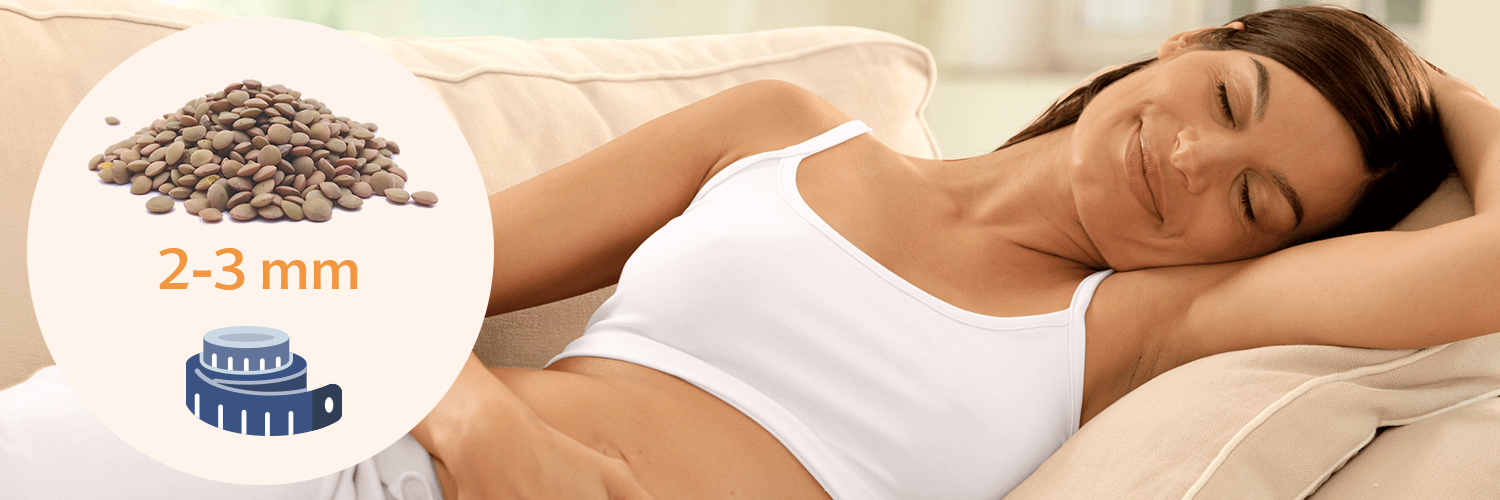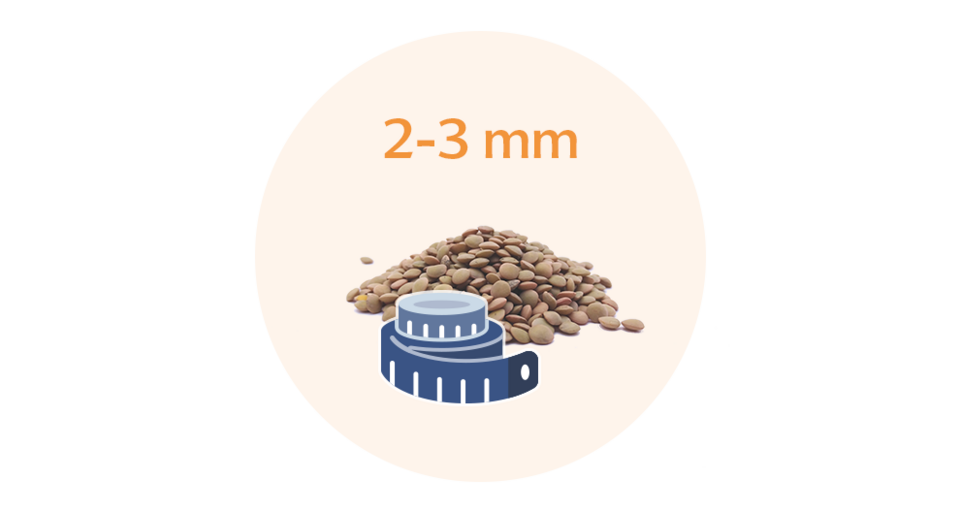In week 6, you will be able to see your baby clearly in an ultrasound scan as a little lump in the amniotic sac, which will show up as a clearly defined black cavity. This lump will grow from week to week but, for now, it’s around 3-4 millimetres in size (so about as big as a lentil).
Pregnancy weeks:
Week 6 of pregnancy: Your baby can now be seen with an ultrasound scan

Size of your baby in week 6
Your baby’s development
What it’s like for the mum-to-be in week 6
Top tips
Questions you may want to ask your doctor or midwife
Size of your baby in week 6

Your baby’s development
Peanut’s little heart is beating quickly and, if you know what you’re looking for, you’ll be able to make out the rear part (which in time will form their back) and the strand which will form their spine.
This strand goes down from their neck to the two separate “branches” that will form your baby’s legs. It ends lower down as a little tail – like you’d expect to see on an animal – which will disappear later on.
At this stage, a doctor will be able to detect if you’re pregnant with twins via ultrasound by the two little hearts beating away in your womb.
In the first few weeks of your pregnancy, your baby’s head is comparatively large compared to the rest of their body because their head needs to develop in order to house their brain, which will control further growth.
The blueprint for this little person, including each stage of their development, was determined in detail at fertilisation.
During the first few weeks of pregnancy, your baby is particularly vulnerable to disorders, as this is when their critical and fundamental structures are developing. Harmful external influences can cause long-term damage to your child in this early stage, so the risk of a miscarriage is unfortunately not yet over.
To ensure Peanut gets everything they need during pregnancy, the placenta and umbilical cord now form. The umbilical cord is the supply line from the placenta to your baby, giving them everything they need, and it connects to their body at the place where their belly button will be after the birth when the umbilical cord is cut. This means the belly button is a small scar, a permanent sign of how they were once connected to you, even though it doesn’t play any particular role once they’re born.
What it’s like for the mum-to-be in week 6
You’ll still feel like you’ve got an emotional mountain to climb – it’s extremely hard to get your head around what’s going on inside your body. In week 6, all sorts of thoughts will be running through your head about your child and your pregnancy that’s just beginning. At this stage, you don’t know what’s in store for you, but your instinct will be to do everything you can to make sure your child grows healthily.
Common signs and symptoms
Hormonal changes
Hormonal changes cause a number of symptoms that will last for the duration of the first trimester, i.e. until the end of the third month of your pregnancy. Frequent symptoms include morning sickness, cardiac problems and sore breasts, as well as feeling tired and listless. After three months, your body will have got a bit more used to the changes that are going on, and the symptoms you experience in the first trimester should disappear.
Some women experience severe symptoms, while others experience only mild symptoms or even none at all. It’s also possible that you won’t experience any nausea during those first three months. Symptoms and their severity can vary enormously, and they depend to a large degree on your psychological state, though your body’s adaptability also plays an important role.
Abdominal pains
Other symptoms of pregnancy during the first few weeks may include a pulling sensation in your
abdomen, other abdominal pain or stomach aches. This is because the ligaments holding your uterus in place are stretching, which they have to do in order to adapt to your growing uterus as pregnancy progresses. The thickening of the protective secretions in your cervix can also sometimes result in an increased vaginal discharge, which is normal provided that it does not smell and has a clear or milky white colour.
Top tips
- If you don’t regularly wear a bra, you should now always wear one as it will help reduce breast soreness.
- Make sure you eat lots of fresh fruit and vegetables. Vitamins B6 and B12, folic acid, iron, zinc and magnesium are extremely important right now.
- Aromatherapy can be very helpful if you feel tired and nauseous – find out which fragrances will help you the most.
- Make sure you get sufficient exercise, which will help avoid fatigue.
Questions you may want to ask your doctor or midwife
Signs of a potential miscarriage
Stomach ache, a pulling sensation in your abdomen and other abdominal pains are signs of pregnancy, but they can vary in terms of severity. If you experience increased or rhythmic pains, or if you bleed more heavily than you do during your periods, this could be a sign of an imminent miscarriage. As always throughout your pregnancy, see your doctor or midwife immediately if your symptoms are unclear or ongoing.
Information about the author:
Juliane Jacke-Gerlitz is a registered nurse. She has been working in the field of mother and breastfeeding counselling for more than ten years. Currently she is working as a medical writer and psychological consultant. Juliane Jacke-Gerlitz has been married for 22 years, is a mother of eight children and lives with her family in Halle.




